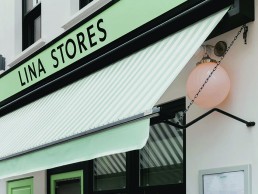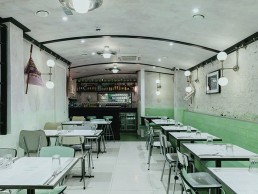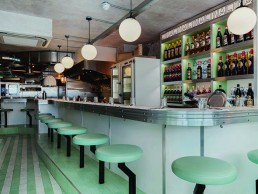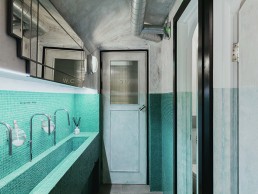
Lina Stores, UK
The iconic Italian deli, Lina Stores, in London has a newly opened restaurant and bar with interior design completed by Red Deer.
The original Lina Stores delicatessen opened in London in 1944, and delivered a strong mid-century Art Deco aesthetic that Red Deer architectural practice wanted to use as inspiration for the opening of neighbouring store – 51 Greek Street, Soho. London-based architectural firm Red Deer was brought on board by The White Rabbit Fund to be responsible for designing the interior scheme for the bar and restaurant. Working collaboratively alongside the owners of the Lina Stores, the team conceived a contemporary dining experience, which connects a ground floor open kitchen bar with a downstairs restaurant.
Taking inspiration from the original Lina Stores, Art Deco cafes and bistros of Europe, Red Deer has sensitively reimagined many recognisable stylistic elements and materials of the pistachio-green and white Brewer Street namesake, to create an evocative and authentic design for the new restaurant and bar.

Architect Lionel Real de Azúa recounted the initial approach: “We didn’t want to duplicate the design of the original Lina Stores, opened in 1944, in the restaurant. We looked for visual cues at the original deli that we could bring over to 51 Greek Street. The strong branding and design of the original and iconic deli, as well as its friendly, welcoming environment also needed to be present in the restaurant. We wanted our design to be true to the values and aesthetic of the deli, but at the same time innovative and contemporary and I think we achieved that by adding a fresh modern twist.”
Inside, the restaurant has varying levels and heights throughout the dining and bar areas, including high counter seating. When first entering, the dining space has a risen twelve-seat diner characterised by a sleek Formica bar with fluted aluminium detailing, concrete bar top and pale green leather bar stools. The internal walls and ceiling have remained untouched to add a contrast to the modern additions.
Red Deer enhanced the rawness of the original building by exposing brickwork, piping and ventilation systems. The studio also used a highly texturised plaster mix containing leftover coffee beans from the original Lina Stores Deli.
“As a practice, re-use is of great importance to us. For the design of Lina Stores, 51 Greek Street, we reclaimed where we could and played with the innovative repurposing of materials,” explained Real de Azúa.
The different materials and textures used play an important role in this interior design and are utilised to differentiate between different zones. The flooring is a mix of traditional green and white terrazzo and the dining furniture is a combination of bespoke Carrara marble and aluminium tables, paired with reclaimed Formica dining chairs and fixed tiled green banquettes with leather seat pads.
Architect Gianna Pagliarulo described the furnishings: “We designed the tables with the help of graphic designers EverythingInBetween. We originally wanted a graphic inlay on the tables and they came up with the idea to use the Lina logo on the four corners.


“The client, White Rabbit Fund, was really involved in the project from start to finish, even requesting a romantic seat in the corner,” she added. “We wanted to bring continental touches to the façade and it was non-negotiable that there would be a mosaic floor to greet the guests. Not many Soho façades are tiled, so this was key to this continental design. We even had in an input on the music selection!”
Lighting was a major detail in the design plans for the interior scheme and had to carry through the Art Deco and reclamation theme throughout the premises. Decorative lighting played a key part in adding softness and warmth to balance out the concrete bar top, marble, tile, aluminium materials and cool pastel green colour palettes.
Real de Azúa explained the choices of lighting fixtures used in the design to darc: “We chose outdoor wall mounted globe lights for the exterior of the restaurant from Peter Reid Lighting, and similar reclaimed globe pendants to hang across the open plan kitchen counter inside. These created spotlights of soft warm diffused lights and are very reminiscent of those used in the mid-century Art Deco cafes and bistros of Italy. We also used reclaimed reeded pillar wall lights in the rear part of the kitchen to highlight and accent the area. Again, a very Art Deco mid-century style, the fluted glass complimented the fluted glass we used in the exterior windows and interior staircase.
“Downstairs in the main restaurant we used a mixture of further reclaimed decorative lighting; mini globe wall lights and almost space-age looking flush ceiling aluminium and glass lights. In the bar area we again used reclaimed reeded pillar wall lights to really differentiate this area. The cavernous structure of the basement restaurant has an intimate feel and we wanted to the use the lighting to emphasise that and not be too bright or clinical. We fitted dimmers to all of the lighting across the restaurant so they can be adjusted for more moodier lighting in the evening.”
Similar to the external globe lights, more globes were hung over the counter across the open plan kitchen, which echo the original designs of the older Lina Stores. To celebrate the heart of the restaurant, accent reeded Art Deco glass pillar lights were added to the rear of the kitchen. The high polished aluminium and glass created a sparkling contrast to the raw textures of the walls and industrial kitchen aesthetic. A unique feature of the basement dining area is a low, curved ceiling. This proved difficult to hang pendants from, so the the team at Red Deer focused on ambient lighting surrounding the diners.
“We didn’t want to hang pendants that would distract, disrupt and clutter the natural intimate feel of the space,” said Real de Azúa. “We wanted to make the tiled banquette seating a focal point and pendant lights would have distracted from this. Instead we used Mullan Lighting’s Yaounde double globe wall lights, placed vertically rather than horizontally for a more contemporary look. We used polished aluminium and opaque glass flush ceiling lights across the arched ceiling along with some spotlights.
“Downstairs, we incorporated a traditional rich timber aperitif and cocktail bar that feels both classically Italian and Soho-esque. Here we used the same reeded glass pillar lights as we used in the ground floor open kitchen bar.”
Continuing with the theme, the designers also added a reclaimed character to the bathrooms. Old Art Deco ship wall lights with ribbed glass were placed either side of a brass Art Deco mirror, and hidden strip lighting was used to illuminate the basins.
“The main challenge was creating a restaurant very much inspired by the Lina Stores deli, but that didn’t eclipse it – we needed to compliment the original deli and create a concept that worked alongside it, especially as both sites are in walking distance of each other in Soho,” reflected Real de Azúa.



